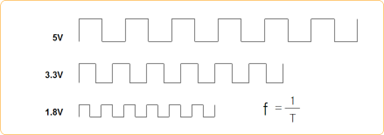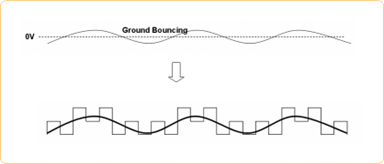AGND/Power-Net Clearance
This item reports problems when low frequency power and high frequency signal traces are routed too close to each other.
Signal line is a digital signal which is represented by a voltage of 1 and 0. The problem is that fluctuation of low frequency power affects the signal line. In other words, a fluctuation of power affects the signal line’s voltage.
- Item: Enter the item name. This will be written in the report for reference.
- PWR/AGND: Select Power/Analog GND net from Net Group list.
- Net: Select High Speed Signal Net Group.
- Start Component/End Component: A test will be performed between the start component and the end component.
- Pin Escape: Enter a radius of circular region around pins to be excluded for the rule check.
- Via Escape: Enter a radius of circular region around vias to be excluded for the rule check.
- Clearance: Set a clearance for each Net Group on the same layer.
- L1 Clearance: Set a clearance to the nearest layers above and below.
- L2 Clearance: Set a clearance to the 2nd nearest layers above and below.
- Minimum: Report the shortest point of each segment, otherwise report all failed point of each segment.
- Composite Net: DFE uses composited power net instead of single power
net.
- Passive Comp: The DFE makes a composite net for which are connected through this passive component.
- Exception Net: Nets which should not be merged into the composite net.
- Parallel Only: The DFE will check only the parallel section of target nets.
- GND Net If the GND Net exists between power net and signal net, the result will be excluded.

Figure 1.

Figure 2.